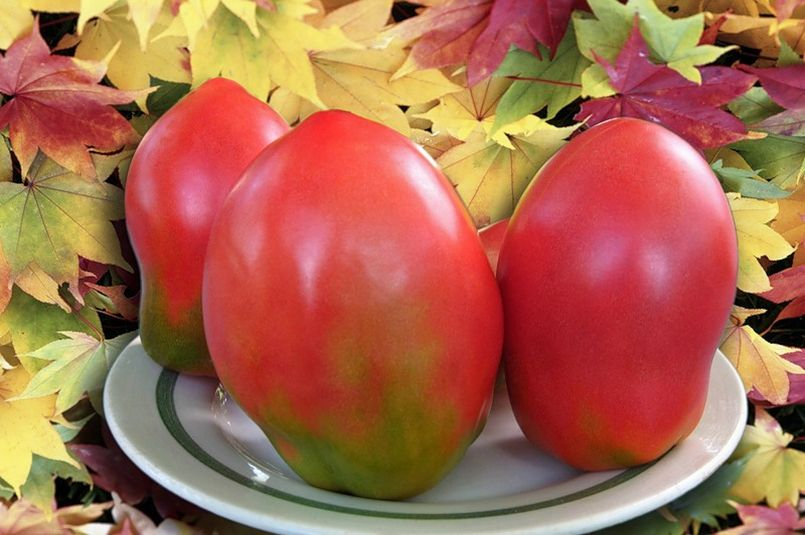 The tomato variety Dulsinea belongs to the category of mid-ripening plants and reaches 1.6 m in height. It is recommended to grow it in greenhouses or under temporary film shelters, until the night frosts completely stop.
The tomato variety Dulsinea belongs to the category of mid-ripening plants and reaches 1.6 m in height. It is recommended to grow it in greenhouses or under temporary film shelters, until the night frosts completely stop.
The peculiarity of the fruit is a surprisingly beautiful pink color and fragrant fleshy flesh.
Content
Grade description
The bushes are indeterminate, so with the beginning of July, careful pinching of the tops is necessarily carried out. This will allow directing nutrients to the development and ripening of fruits, and not the further growth and density of tops. Tomatoes are grouped in 4-6 pieces in each brush. The first of them is tied over the seventh leaf, and each subsequent - after another 3 sheets. So that the bushes can withstand the load of fruits, they must be tied up. It is best to use the trellis method, in which support is given primarily to the brushes themselves.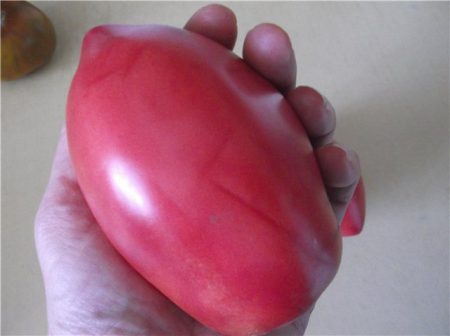
The average weight of tomatoes is 150 - 250 g. They can be used fresh, as well as for the preparation of salads, sauces and juices. If the planting of seedlings grown from March is reproduced in the second half of May or early June, then the first fruits can be harvested in mid-July. The variety has a long fruiting period, so the ripening of the crop stretches until mid-September.
Growing recommendations
You can count on good tomato yields if you start growing with self-sowing seeds. Sowing must be carried out 50-60 days before the planned planting in the ground. The container with soil and seeds should be in a bright room at an air temperature of 23 - 25 degrees Celsius. Among the mandatory requirements for the cultivation of tomato seedlings of Dulsinea, it is worth highlighting timely moderate watering: the earth should be moist, but without excess and stagnation of water, since this blocks the access of oxygen to the root systems. The total vegetation period takes 108 - 115 days from the moment of the appearance of the first seedlings.
Tomatoes are a type of nightshade crops, therefore, all kinds of manipulations with the root system of plants can lead to a halt in the development of bushes or to an insufficient crop. In order not to injure the plants during the picking process, you can plant the seeds in separate small containers, and then transplant them on a permanent ground with a lump of earth.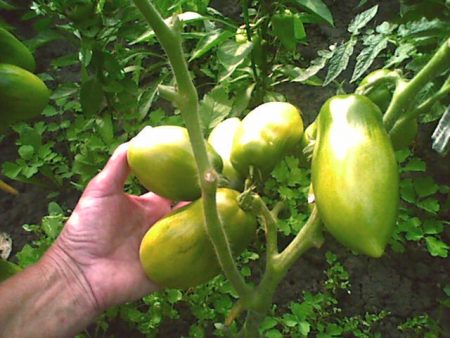
It is possible to transplant into permanent soil only after the earth warms up to 16 - 18 degrees, and the possibility of returning spring night frosts will be minimal. Since the bushes grow tall and voluminous, no more than 3 bushes per 1 sq.m should be planted. 10 days after planting, it is necessary to carry out a neat hilling of the bushes. This will save more moisture inside, as well as protect plants from various diseases. Since it is common for tomatoes to form roots from small processes on stems, hilling strengthens the system, which means that the plant becomes less vulnerable.
When choosing a site for growing Dulsinea tomatoes under a temporary film shelter, preference should be given to well-lit areas or a small partial shade. Planting tomatoes on cold drafts is not allowed.
Soil Preparation Recommendations
The optimal conditions for growing Dulcinea tomatoes are:
- sufficient soil friability,
- its full fertilizer;
- neutral acidity;
- compliance with crop rotation principles;
- moderate humidity.
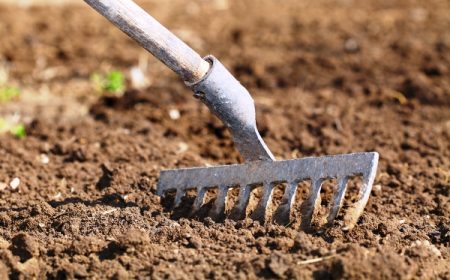
The soil must be friable so that the root system can receive the necessary oxygen. Therefore, in the choice of soil, clay and marshy soils should not be chosen. Ordinary garden land can be supplemented with coarse river sand. The second important point concerns regular surface treatment to prevent crusting.
As for soil fertilizer, you need to think about it in the fall. For this, bird droppings, manure or rotted compost are suitable. In this case, the site must be dug up. Before transplanting seedlings, mineral complexes with the obligatory presence of calcium, potassium, nitrogen and copper are added to the soil. Fertilizing can be carried out by watering the dissolved elements in warm water. Of the required additional fertilizers, it is also worth highlighting the moment before the first flowers appear and before the fruits ripen. In any case, the use of complex mineral fertilizers should be carried out no more than once every 4 to 5 weeks.
Sensitive roots do not tolerate the increased acidity of the soil. If plantain, horsetail or buttercup most often sprouts on the site, this indicates increased acidity. It is possible to normalize the condition of such soil by making sifted wood ash or lime in the calculation of 20-30 kg per 1 hundredth of a site.
As for crop rotation rules, it is not recommended to grow tomatoes after pepper or any other nightshade crops. Good precursors to tomatoes are potatoes and legumes. Moderate soil moisture is necessary for proper nutrition of bushes with tomatoes, while the stagnation of water in the soil is much more harmful than a short drought. When growing Dulsinea tomatoes in greenhouse conditions, it is necessary to maintain a soil and air humidity level of about 60%.
Diseases and pests
Of the most dangerous diseases for tomatoes, Dulcinea is the defeat of Fusarium, which is manifested by the rapid decay of the root system and plant legs. In order to protect plants in advance, their seeds are treated with a bright pink solution of potassium permanganate even before sowing. To prevent the manifestation of the disease will allow the protection of tomato bushes from sudden changes in air temperature, as well as sudden changes of too dry soil to excessively wet.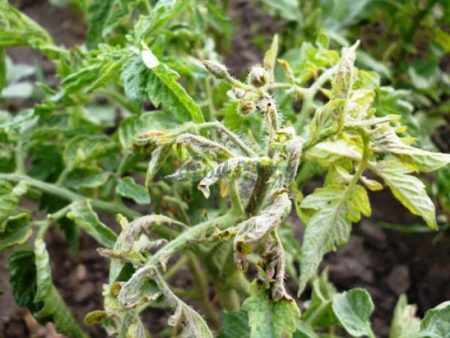
In the prevention of disease of bushes with whitefly, you can use a two-day garlic infusion, for the preparation of which you need 250 - 300 g of squeezed garlic in 8 - 9 liters of water. An alternative can be a regular soda solution, which uses 250 g of powder per 10 liters of water. Ready-made solutions need to carefully spray each bush. The first treatment can be carried out no earlier than 2 - 2.5 weeks after planting the seedlings, and another week is sure to be sprayed again.
In the fight against insects fungicides are often used. The basic rule for their use concerns the need to carry out the work themselves no later than 2 weeks before the planned harvest. Special attention must be paid to their own safety when working with chemical poison. Spraying is recommended in the early morning before sunrise or late in the evening. This will allow the substance to soak into the leaves before it evaporates under the influence of sunlight.
Reviews
Margarita Petrovna, 48 years old
For the preventive protection of tomato bushes, you can use a two-day infusion of celandine. To prepare it, you need to take 8 - 9 liters of clean water and at least 1 - 1.5 kg of chopped fresh grass. Spraying is best done in the early morning. Repeat the procedure again after 10 days, having prepared for this a fresh two-day infusion.
Vasily Ivanovich, 64 years old
To process tomato bushes as carefully as possible, seedlings on the site should be planted at a distance of 45 - 50 cm. With the onset of hot summer, you should take care of mulching the root systems: the soil under the bushes can be covered with straw or any other non-woven material that would not allow sunlight to soil and thereby protected the existing moisture from evaporation.




 Low-growing tomatoes, without pinching: 5 of the most delicious varieties
Low-growing tomatoes, without pinching: 5 of the most delicious varieties Why tomato seedlings grow poorly
Why tomato seedlings grow poorly We grow a tomato in a shell
We grow a tomato in a shell Growing tomatoes without watering according to the method of Kazarin
Growing tomatoes without watering according to the method of Kazarin